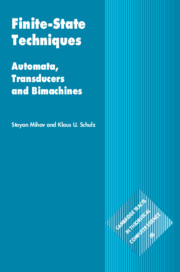Refine search
Actions for selected content:
3326 results in Artificial Intelligence and Natural Language Processing
High-dimensional distributed semantic spaces for utterances
-
- Journal:
- Natural Language Engineering / Volume 25 / Issue 4 / July 2019
- Published online by Cambridge University Press:
- 31 July 2019, pp. 503-517
-
- Article
- Export citation

Finite-State Techniques
- Automata, Transducers and Bimachines
-
- Published online:
- 29 July 2019
- Print publication:
- 01 August 2019
An overview of word and sense similarity
-
- Journal:
- Natural Language Engineering / Volume 25 / Issue 6 / November 2019
- Published online by Cambridge University Press:
- 25 July 2019, pp. 693-714
-
- Article
-
- You have access
- Open access
- HTML
- Export citation
Measuring diachronic language distance using perplexity: Application to English, Portuguese, and Spanish
-
- Journal:
- Natural Language Engineering / Volume 26 / Issue 4 / July 2020
- Published online by Cambridge University Press:
- 24 July 2019, pp. 433-454
-
- Article
- Export citation
A survey of 25 years of evaluation
-
- Journal:
- Natural Language Engineering / Volume 25 / Issue 6 / November 2019
- Published online by Cambridge University Press:
- 19 July 2019, pp. 753-767
-
- Article
-
- You have access
- Open access
- HTML
- Export citation
Combining n-grams and deep convolutional features for language variety classification
-
- Journal:
- Natural Language Engineering / Volume 25 / Issue 5 / September 2019
- Published online by Cambridge University Press:
- 18 July 2019, pp. 607-632
-
- Article
-
- You have access
- Open access
- HTML
- Export citation
Neural morphosyntactic tagging for Rusyn
-
- Journal:
- Natural Language Engineering / Volume 25 / Issue 5 / September 2019
- Published online by Cambridge University Press:
- 18 July 2019, pp. 633-650
-
- Article
- Export citation
Designing a virtual patient dialogue system based on terminology-rich resources: Challenges and evaluation
-
- Journal:
- Natural Language Engineering / Volume 26 / Issue 2 / March 2020
- Published online by Cambridge University Press:
- 15 July 2019, pp. 183-220
-
- Article
- Export citation
Detecting light verb constructions across languages
-
- Journal:
- Natural Language Engineering / Volume 26 / Issue 3 / May 2020
- Published online by Cambridge University Press:
- 15 July 2019, pp. 319-348
-
- Article
- Export citation
Term evaluation metrics in imbalanced text categorization
-
- Journal:
- Natural Language Engineering / Volume 26 / Issue 1 / January 2020
- Published online by Cambridge University Press:
- 12 July 2019, pp. 31-47
-
- Article
- Export citation
NLP commercialisation in the last 25 years
-
- Journal:
- Natural Language Engineering / Volume 25 / Issue 3 / May 2019
- Published online by Cambridge University Press:
- 15 May 2019, pp. 419-426
-
- Article
-
- You have access
- Open access
- HTML
- Export citation
NLE volume 25 issue 3 Cover and Back matter
-
- Journal:
- Natural Language Engineering / Volume 25 / Issue 3 / May 2019
- Published online by Cambridge University Press:
- 15 May 2019, pp. b1-b2
-
- Article
-
- You have access
- Export citation
Annotation projection for temporal information extraction
-
- Journal:
- Natural Language Engineering / Volume 25 / Issue 3 / May 2019
- Published online by Cambridge University Press:
- 15 May 2019, pp. 385-403
-
- Article
- Export citation
NLE volume 25 issue 3 Cover and Front matter
-
- Journal:
- Natural Language Engineering / Volume 25 / Issue 3 / May 2019
- Published online by Cambridge University Press:
- 15 May 2019, pp. f1-f2
-
- Article
-
- You have access
- Export citation
Anniversary article: Then and now: 25 years of progress in natural language engineering
-
- Journal:
- Natural Language Engineering / Volume 25 / Issue 3 / May 2019
- Published online by Cambridge University Press:
- 15 May 2019, pp. 405-418
-
- Article
- Export citation
Annotating a broad range of anaphoric phenomena, in a variety of genres: the ARRAU Corpus
-
- Journal:
- Natural Language Engineering / Volume 26 / Issue 1 / January 2020
- Published online by Cambridge University Press:
- 07 May 2019, pp. 95-128
-
- Article
- Export citation
A new approach for textual feature selection based on N-composite isolated labels
-
- Journal:
- Natural Language Engineering / Volume 26 / Issue 2 / March 2020
- Published online by Cambridge University Press:
- 29 April 2019, pp. 221-243
-
- Article
- Export citation
Query-based summarization of discussion threads
-
- Journal:
- Natural Language Engineering / Volume 26 / Issue 1 / January 2020
- Published online by Cambridge University Press:
- 16 April 2019, pp. 3-29
-
- Article
-
- You have access
- Open access
- HTML
- Export citation
Robust stylometric analysis and author attribution based on tones and rimes
-
- Journal:
- Natural Language Engineering / Volume 26 / Issue 1 / January 2020
- Published online by Cambridge University Press:
- 10 April 2019, pp. 49-71
-
- Article
- Export citation
Integrating LSA-based hierarchical conceptual space and machine learning methods for leveling the readability of domain-specific texts
-
- Journal:
- Natural Language Engineering / Volume 25 / Issue 3 / May 2019
- Published online by Cambridge University Press:
- 05 April 2019, pp. 331-361
-
- Article
- Export citation
